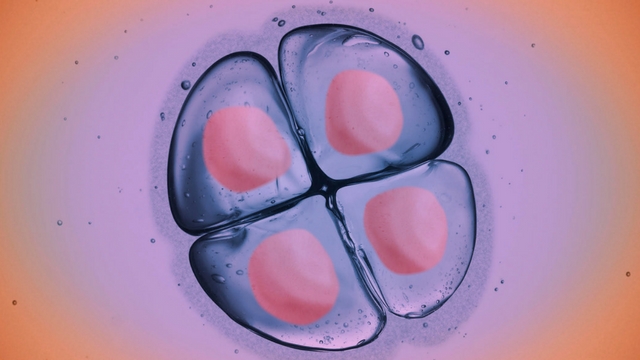Highlights
- •Human in vitro differentiation captures ICM-to-hypoblast fate decision
- •Hypoblast increases at the expense of both epiblast and trophoblast
- •Hypoblast induction requires a critical period of FGF stimulation
- •Hypoblast formation in the human blastocyst requires FGF signaling
Summary
The hypoblast is an essential extraembryonic tissue set aside within the inner cell mass in the blastocyst. Research with human embryos is challenging. Thus, stem cell models that reproduce hypoblast differentiation provide valuable alternatives. We show here that human naive pluripotent stem cell (PSC) to hypoblast differentiation proceeds via reversion to a transitional ICM-like state from which the hypoblast emerges in concordance with the trajectory in human blastocysts. We identified a window when fibroblast growth factor (FGF) signaling is critical for hypoblast specification. Revisiting FGF signaling in human embryos revealed that inhibition in the early blastocyst suppresses hypoblast formation. In vitro, the induction of hypoblast is synergistically enhanced by limiting trophectoderm and epiblast fates. This finding revises previous reports and establishes a conservation in lineage specification between mice and humans. Overall, this study demonstrates the utility of human naive PSC-based models in elucidating the mechanistic features of early human embryogenesis.
Introduction
At the onset of early human embryogenesis, a fertilized zygote undergoes continuous cell division, cellular diversification, and spatial organization to form a hollow spherical structure, the blastocyst. The blastocyst consists of three primary lineages: the epiblast, trophectoderm, and hypoblast (also known as primitive endoderm), which will develop into the embryo proper, placenta, and yolk sac, respectively. Studies in mice have established a model of sequential lineage segregation during pre-implantation embryogenesis. This begins with the first lineage segregation, which sets apart the extraembryonic trophectoderm from the inner cell mass (ICM),1,2,3,4 followed by a second binary fate decision when the ICM resolves into naive epiblast and hypoblast.5,6,7,8 Morphological observation, immunostaining, and recent advances in single-cell transcriptome analysis of human embryos suggest that the sequential lineage segregation model broadly stands in humans.9,10,11 The segregation of the trophectoderm in humans begins around day 4 after fertilization (4 dpf) in the morula, followed by hypoblast lineage segregation around 6–7 dpf in the ICM of the blastocyst.10,12,13 Cross-species comparative studies have revealed both conserved and human-specific features of lineage specification.14,15,16 However, owing to limited access to human embryos, applicable approaches, and ethical considerations, knowledge of the regulatory mechanisms controlling human hypoblast lineage segregation is fragmentary. Given that hypoblast derivatives play an integral role in supporting and patterning the primate embryo,17 understanding how this lineage emerges and progresses is vital.
Human pluripotent stem cells (PSCs) and embryo models can be valuable tools to study cell fate specification. Human naive PSCs display close similarity to the epiblast in 6–7 dpf blastocysts.18,19,20,21 We found that human naive PSCs maintained in PXGL18 medium retain a greater degree of developmental plasticity compared with mouse embryonic stem cell (ESC) counterparts.22,23 Inhibition of MEK/ERK (PD0325901), supplemented with inhibition of Activin/Nodal signaling (A83-01) enables naive PSCs to differentiate to the trophectoderm.22 Interestingly, 1 day of exposure to PD0325901 and A83-01 yielded a mixed cell culture comprising all three lineages in the blastocyst, including a small population of hypoblast-like cells.22 This cellular plasticity has been exploited to form three-dimensional (3D) organoids resembling the blastocyst (known as blastoids) that share morphological and transcriptomic similarity to the pre-implantation embryo.24,25,26 Signaling pathways involved in trophectoderm specification in vitro have been described22,23,27 but the naive PSC-to-hypoblast differentiation path has not been properly characterized. Furthermore, a key question remains as to how the in vitro differentiation process relates to hypoblast lineage development in the embryo. Here, we delineate the in vitro naive PSC-to-hypoblast differentiation trajectory and compare it with embryonic lineage segregation. We also explore the role of fibroblast growth factor (FGF) signaling, which is critical for hypoblast specification in mice but has previously been suggested to be less important in humans.13,28
Results
Initial MEK/ERK and Activin/Nodal inhibition enables hypoblast differentiation from naive PSCs
We have previously shown that human nPSCs differentiate mainly (>60%) to the trophectoderm over 3 days of continuous culture in N2B27 basal medium containing the MEK/ERK inhibitor (PD0325901) and Activin/Nodal inhibitor (A83-01).22 By contrast, 1 day in PDA83 followed by N2B27 alone yielded a mixed culture containing a small population of hypoblast cells.22 We used this adherent nPSC differentiation to investigate the signaling requirements for hypoblast differentiation. To this end, we generated an OCT4-EmGFP29 and SOX17-tdTomato30 knockin double reporter naive induced PSC (iPSC) cell line, niPSC-OS1 (Figures S1A and S1B). niPSC-OS1 cells expressed the pluripotency marker OCT4-EmGFP in PXGL, but few, if any, cells expressed the hypoblast marker SOX17-tdTomato during self-renewal (Figure S1C). SOX17-tdTomato-positive cells became readily visible under fluorescence microscopy in differentiation (Figures 1A and 1B). We quantified reporter expression by flow cytometry over the course of the 3 days of differentiation in either continuous PDA83 (PA condition) or 1 day in PDA83 with release into N2B27 (PA-N condition) (Figures 1A and 1C). The PA condition predominantly gave rise to reporter-negative cells, with a minor population of OCT4-positive cells. Little or no SOX17-tdTomato expression was recorded (Figures 1C and S1D). The double-negative cells expressed the trophectoderm marker GATA3 (Figure S1E). In the PA-N condition, SOX17-tdTomato expression emerged after 24 h in N2B27 (Figure S1F). Typically, after 3 days’ culture in PA-N, we observed a mixed culture with ∼20% SOX17-tdTomato-positive, ∼60% OCT4-EmGFP-positive, and ∼20% double-negative cells (Figure 1C). Immunofluorescence (IF) and reporter expression confirmed the presence of pluripotency, hypoblast, and trophectoderm lineage markers in the three subpopulations in PA-N cultures (Figure S1G). Importantly, when plated directly into N2B27 without PDA83 exposure, the culture largely remained OCT4-EmGFP-positive with only ∼1% of SOX17-tdTomato-positive cells (Figure 1D), indicating that exposure to PDA83 is important for both trophectoderm and hypoblast specification.







